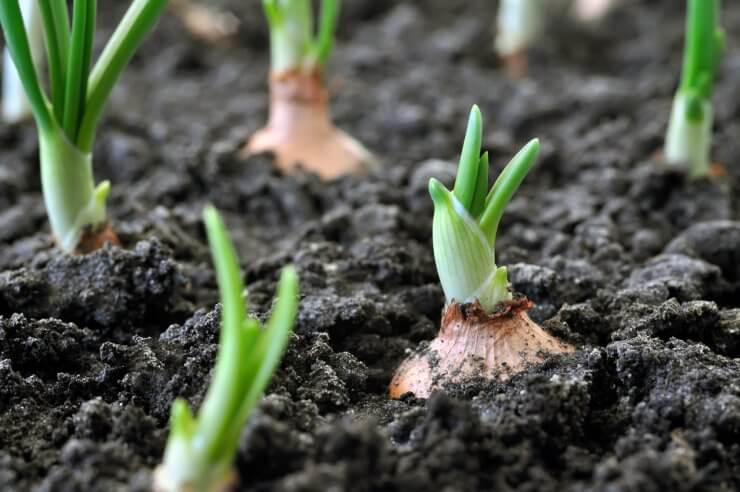
Young onion plants in great soil
Want healthy onions? Make sure you have healthy soil. Onions like well-drained soil with a high level of organic matter and a pH between 6.0 and 7.0. Amend your soil to the right pH only after you’ve tested your soil. This is a step many home gardeners skip; don’t do it! Send a soil sample to your local extension center, take it to a garden center that does soil testing, or purchase a kit and do it yourself. The results will show you where and whether you need to amend your soil. If you don’t need additional nutrients and you add them, you’re not going to be doing your onions any favors. Give them the balanced diet they need.
Onions aren’t nitrogen hogs, but they do need a good supply of nitrogen to grow well. But go easy on the application of additional nitrogen, or your onions could wind up with irreversible problems.
As for organic matter, you can add well-rotted manure or compost in the fall or spring. Never use fresh manure, as it could contain bacteria or weed seeds.
And it’s alright if you don’t make your own compost—you can buy bulk compost from most gardening supply stores. Try to find “certified compost” with the U.S. Composting Council’s Seal of Testing Assurance (STA)—their rigorous testing process and standards will ensure you get quality compost.
If you have acidic soil, you’ll want to add lime, as onions grow best in soil with a pH between 6.0 and 7.0. If your soil pH is too high, then you can lower it with sphagnum peat or granular sulfur. While sphagnum peat works more quickly, it is definitely more expensive than granular sulfur.
With your compost and amendments on top of your soil, use a spade fork to turn the soil over and mix everything together. Healthy soil gives your onion plants a healthy start!
Wherever you grow them, onions like well-drained, slightly acidic soil with a pH level between 6.0 and 7.0. Unless you’re an old hand at growing onions—and even if you are—get your soil tested. Using a home-test kit is the cheapest and easiest way to check the pH level—only use the more expensive and time-consuming soil-test methods (when you send the soil to a lab for testing) when you’re examining full soil composition, elements, and possible contaminants.
When your soil test results are ready, follow the recommendations for amending your soil.
What type of soil do you use to grow your onions? Do you use compost or manure? What are your best tips for creating optimal soil for your onions? Please share your techniques with us.


 Previous
Previous


In paragraph five “onions like slightly acidic soil with a ph between 6.0 and 7.0” This is inconsistent with your discussion ph in the other parts of this article. ph of 7.0 is slightly alkaline. Thank you for the advice.
Ph of 7 is neutral, so anything between 6 & less than 7 is slightly acidic.